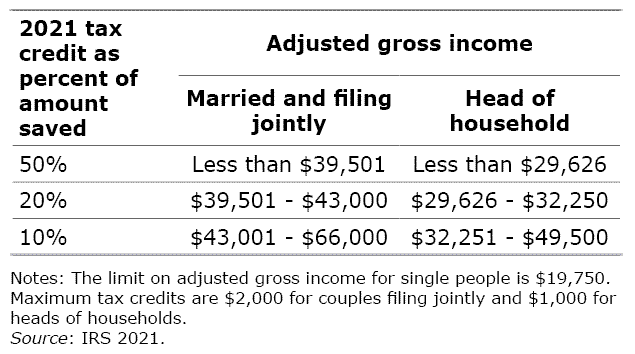
Think of Saver’s Tax Credit as Free Money
Life’s unpleasant surprises – a new set of tires or a big vet bill – can get in the way of saving money for retirement. This is especially true for low-income workers.
But if they are able to save a little here and there, the federal government provides a very big assist through its Saver’s Credit. Unfortunately, low-income workers are also the least likely to be aware the tax credit exists.
 Here’s how the Saver’s Credit works. The IRS returns half of the amount saved over the year – up to certain limits – by a head of household earning less than $29,626 or a couple earning less than $39,501.
Here’s how the Saver’s Credit works. The IRS returns half of the amount saved over the year – up to certain limits – by a head of household earning less than $29,626 or a couple earning less than $39,501.
So, the head of household with earnings under the income limit who saves $2,000 in a tax-exempt retirement plan like an IRA or an employer 401(k) would get back the IRS’ maximum credit of $1,000. And the couple that saves $4,000 would get back the $2,000 maximum.
 Granted, these are very large sums for low-income workers. But if they can manage to save a little bit every week, the Saver’s Credit is effectively free money from the federal government.
Granted, these are very large sums for low-income workers. But if they can manage to save a little bit every week, the Saver’s Credit is effectively free money from the federal government.
Smaller tax credits are available to people with slightly higher incomes. Individuals and couples do not qualify if they earn more than $49,500 and $66,000, respectively.
Unfortunately, only about a third of households earning under $50,000 are aware of the credit, according to a Transamerica Institute survey.
Now that you know, start saving. You’ll get a big chunk of it back.
Squared Away writer Kim Blanton invites you to follow us on Twitter @SquaredAwayBC. To stay current on our blog, please join our free email list. You’ll receive just one email each week – with links to the two new posts for that week – when you sign up here. This blog is supported by the Center for Retirement Research at Boston College.
Comments are closed.







One of the obstacles to using this credit is that in many cases the very low income taxpayers owe no tax. If they owe no tax, the credit is useless, because it’s a non-refundable credit.
In my work as a VITA volunteer we see a number of people who are eligible for the 10% credit, but very few who can take advantage of the 50% credit (the 20% group is a very narrow income window). Sometimes I see a taxpayer who, despite low income, is putting money into an employer plan — I get excited, thinking they’ll get to use the credit, but then it doesn’t end up helping them because their taxable income was already down to zero.
To dream big about helping low-income people save for retirement, we should make it a refundable credit.
Barb-
Sure wish I’d interviewed you before I wrote this blog!
Thank you so much for giving us your experience on the ground and in the real world.